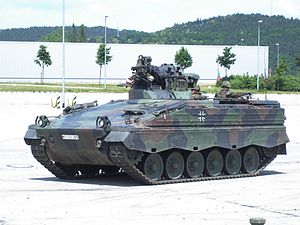Marder (IFV)
| Marder 1 | |
|---|---|

A Marder IFV
|
|
| Type | Infantry fighting vehicle |
| Place of origin | West Germany |
| Service history | |
| In service | 1971–present |
| Used by | Bundeswehr |
| Wars | War in Afghanistan |
| Production history | |
| Designer | Rheinmetall Landsysteme |
| Designed | May 7, 1971 |
| Manufacturer | Rheinmetall Landsysteme |
| Specifications (Marder 1) | |
| Weight |
28.5 t (31.4 short tons) marder 1A1/A2 |
| Length | 6.79 m (22 ft 3 in) |
| Width | 3.24 m (10 ft 8 in) |
| Height | 2.98 m (9 ft 9 in) |
| Crew | 3+7 |
|
|
|
| Armor | Welded steel, protection up to 20 mm APDS DM43 from 0 m and 25 mm APDS from 200 m (220 yd) |
|
Main
armament |
20 mm Rheinmetall MK 20 Rh 202 automatic cannon MILAN ATGM launcher |
|
Secondary
armament |
7.62 mm MG3 machine gun |
| Engine |
MTU MB 833 Ea-500 diesel engine 441 kW (591 hp) |
| Power/weight | 15.7 kW/t (21.1 hp/t) |
| Transmission | RENK HSWL 194 |
| Suspension | Torsion bar |
| Ground clearance | 0.45 m (18 in) |
| Fuel capacity | 652 L (143 imp gal; 172 US gal) |
|
Operational
range |
520 km |
| Speed | 75 km/h (47 mph)Marder 1A2 65 km/h (40 mph) Marder 1A3 |
28.5 t (31.4 short tons) marder 1A1/A2
33.5 t (36.9 short tons) marder 1A3
The Marder (German for "marten") is a German infantry fighting vehicle operated by the German Army as the main weapon of the Panzergrenadiere (mechanized infantry) from the 1970s through to the present day. Developed as part of the rebuilding of Germany's armoured fighting vehicle industry, the Marder has proven to be a successful and solid infantry fighting vehicle design. While it does include a few unique features, such as the fully remote machine gun on the rear deck, it is overall a simple and conventional machine with rear exit hatch and side gun ports for mounted infantry to fire through. The Marder is currently being replaced by its successor, the Puma.
Around 2,100 were taken into service by the German Army in the early 1970s, but the vehicle in its German variant was not sold to any foreign militaries. As the German Army began to retire older vehicles, the Chilean government agreed to acquire 200 Marders; the government of Greece has considered the purchase of 450 retired vehicles in the past. Argentina uses a simplified and locally produced variant, the VCTP, and has a number of vehicles based on that platform constructed by Henschel and built by TAMSE.
Development of the Marder ran from January 1960, when the first development contracts were issued, to 7 May 1971, when the first production vehicles were given to the German army.
The vehicle was intended to be an improvement over the Schützenpanzer Lang HS.30. The main requirements were:
Initially, development contracts were awarded to two groups of companies the Rheinstahl group (Rheinstahl-Hanomag, Ruhrstahl, Witten-Annen, Büro Warnecke) and the second group comprising Henschel Werke and the Swiss MOWAG company. This resulted in the production of seven prototype vehicles. A second set of eight prototype vehicles were built between 1961 and 1963. Development priority was then switched for a while to the development of the Jagdpanzer 90 mm Kanone.
...
Wikipedia
